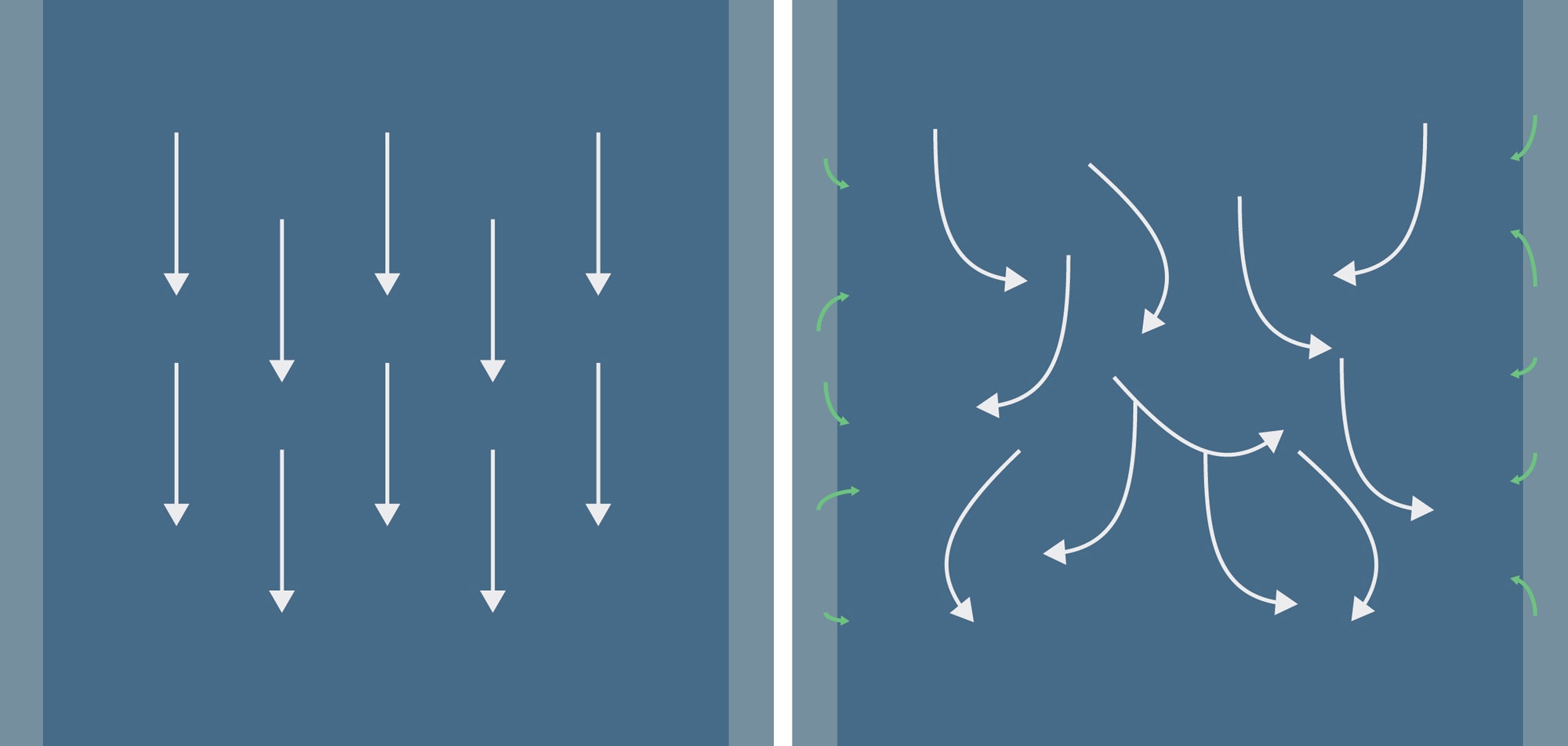“Professor Abbott told us he doesn’t really believe channelling occurs in espresso (except in drastic cases). So if not channelling, then what?” Only a few weeks ago we were telling you that over-extraction isn’t really a thing, and that it’s all caused by channelling; now we’re telling you that channelling doesn’t exist either. What gives, BH?
Well, the good news is we’re not actually setting out to upset the applecart; we just want to look a bit deeper into how water flows during a shot. In doing so, we find we can draw a distinction between the obvious, visible channels that we’re all familiar with, and the subtler and more insidious variations in flow that potentially have a bigger effect on flavour, and are what really determines the limit of how much of the good stuff we can extract.
‘Overextraction’ and Tannins
Firstly, a quick reminder of what’s going on when we talk about overextraction. As extraction increases, we eventually reach a point where the coffee starts to become dry and bitter — this point is what we call the ‘extraction ceiling’. This bitter flavour and dry, astringent feeling are caused by tannins and pseudo-tannins — related compounds such as chlorogenic acid which have a similar effect. These are mostly large molecules, which dissolve slowly into water. This means they only make it into the coffee at very high extraction levels. Because tannins and pseudo-tannins have a similar effect, and both show up in many tests for tannins, both classes of molecules are often just called ‘tannins’ in the coffee industry.
The more even the extraction, the higher the total amount that can be extracted before the dryness from tannins creeps in. With conventional methods, this point might be reached around 22-24% extraction, but Scott Rao and others have recently managed to hit 27% without noticeable astringency.
Channels and Microchannels
We’re all familiar with the appearance of a channel in espresso, whether as a spray from the bottom of a naked portafilter, or a tell-tale blond streak coming from your spouts — a clear sign of very uneven flow through the coffee bed.
In his recent talk at Prufrock Coffee in London, Professor Abbott doubted that this kind of channel has much of an effect, except by simply diluting the coffee, because it affects such a small part of the coffee bed. And indeed, good technique can more or less eliminate this kind of channel and improve extraction as a result, but has a relatively small effect on raising the extraction ceiling.
When watching the relationship between pressure and flow during a shot on the Decent espresso machine, Scott Rao noticed fluctuations in flow even when no visible channelling occurs. Reducing these fluctuations in flow, which he referred to as ‘microchannels’, improved the shot and increased the extraction ceiling dramatically. What seems to be happening here, Abbott speculates, is that the size of the gaps between coffee grinds (pores) changes as the water flows through, carrying fines with it. “It only takes one particle to shift from site A to site B to change [the size of] a pore.”
Poiseuille’s Law
These small changes in pore sizes have an outsized effect on flow, due to an effect called Poiseuilles’s Law, as Matt explained in his talk in Berlin last month (You need a BH Unlimited subscription to open this link). This states that if you double the diameter of a pore, the water flow through it increases by 16 times. This means that the inevitable small variations in the gaps between coffee grinds have a big effect on the flow of water. More water passing through a pore means greater extraction of the surrounding grinds — but Abbott isn’t convinced that this difference in flow alone is enough to explain the extraction of tannins in these areas.
The No-Slip Boundary Condition
The reason high flow alone isn’t enough to explain the extraction of tannins is because of this counterintuitive phenomenon. The no-slip boundary condition states that at the boundary between a solid and a liquid, the flow rate is zero.
 Left: fast flow rate through the pore, but zero flow at the boundaries. Right: Tannins (in green) can only join the flow by diffusion.
Left: fast flow rate through the pore, but zero flow at the boundaries. Right: Tannins (in green) can only join the flow by diffusion.
This means that molecules at the surface can only make their way into the flow of liquid via diffusion, at least until they pass the boundary layer. Diffusion into the main flow of water is “amazingly slow”, Abbott explains, and therefore isn’t enough to explain how tannins escape from the surface.
Reynolds Numbers and Turbulence
In our post on Darcy and Forcheimer flows, we explained that the flow through an espresso puck is turbulent. Instead of passing through the coffee in nice straight lines, the flow has random eddies and currents within it.
 Left: laminar flow / right: turbulent flow.
Left: laminar flow / right: turbulent flow.
The Reynolds number predicts if flow in a liquid will be laminar or turbulent — higher numbers mean a greater chance of turbulent flow. Faster moving liquids have higher Reynolds numbers — so the faster flow through a larger pore is more likely to be turbulent.
This turbulence allows the flow of water to get closer to the surface, pulling the tannins out from the slow-moving boundary layer. So it is this turbulent flow that allows tannins to be extracted, and ruins your shot.
Since limiting the flow rate keeps the Reynolds number down, this also helps to explain how flow profiling can improve a shot, by reducing turbulent flow.
The point is that there doesn’t have to be a defined ‘channel’ through the puck to cause this kind of extraction. Any localised areas of increased flow, due to tiny variations in the size of the space between coffee grinds, can cause an increase in turbulence and thus in the extraction of tannins. Anything that reduces the variation in the size of these gaps, whether that’s more uniform grind size and shape, or better puck preparation, can thus raise the extraction ceiling — and we’re only just starting to find out how high that can go.




https://www.oxfordlearnersdictionaries.com/definition/english/pseudo?q=Pseudo
pseudo- combining form
/suːdəʊ/, /sjuːdəʊ/
/suːdəʊ/
(in nouns, adjectives and adverbs)
not what somebody claims it is; false or pretended
pseudo-intellectual
pseudoscience
Hi Paolo,
Thanks for your comments about tannins. They inspired us to write this paper. https://www.baristahustle.com/white-papers/tannins-in-coffee/ We follow up on Ted Lingle’s point which you mentioned too.
I hope this piece clears up our editorial position on the tannins topic and I hope you don’t find it objectionable if we use this term in future articles.
Thanks again for reading,
BH
The Coffee Brewing Handbook Sca by Ted R. Lingle , Second edition 2011
Page 31. Other Brew Components
“….. showed the highest rate for trigonelline, followed by caffeine, soluble solids, chlorogenic acid, phenolic compounds ( originally and INCORRECTLY classifieds as tannins) and color. “
I think it creates a lot of confusion if you use the name of chemical compounds incorrectly, in fact Ted Lingle specifies it. Tannins are present in wine, tea but not in coffee.
In coffee there are no tannins, you should say phenols and chlorogenic acids and their derivatives, but you cannot write that there are tannins,
you could refer to what Lingle writes in The Coffee Brewing Handbook about confusing these substances
Hi Paolo – thanks for the comment. We often use ‘tannins’ as a shortcut, meaning tannins and so-called pseudo-tannins (such as CGA and other phenolics found in coffee) that have similar effects on precipiating protein, as that’s how most people in the industry refer to them. You’re right though that most of the compounds in this group found in coffee aren’t tannins in the strictest sense, so we’ll make sure to be clear on that.
The Coffee Brewing Handbook Sca by Ted R. Lingle , Second edition 2011
Page 31. Other Brew Components
“….. showed the highest rate for trigonelline, followed by caffeine, soluble solids, chlorogenic acid, phenolic compounds ( originally and INCORRECTLY classifieds as tannins) and color. “
I think it creates a lot of confusion if you use the name of chemical compounds incorrectly, in fact Ted Lingle specifies it. Tannins are present in wine, tea but not in coffee.